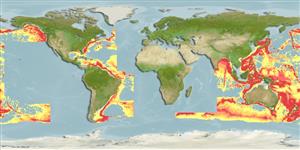Common names from other countries
Classification / Names / Names
Noms communs | Synonymes | Catalog of Fishes (gen., sp.) | ITIS | CoL | WoRMS
Environment: milieu / climate zone / depth range / distribution range
Écologie
; profondeur 100 - 4721 m (Ref. 95072). Tropical
Distribution
Pays | Zones FAO | Écosystèmes | Occurrences | Introductions
Pacific Ocean and Antarctic Indian Ocean: Tropical to polar.
Length at first maturity / Taille / Poids / Âge
Maturity: Lm ? range ? - ? cm
Life cycle and mating behavior
Maturité | Reproduction | Frai | Œufs | Fécondité | Larves
Members of the class Ophiuroidea are mostly gonochoric, others are protandric. Fertilization is external. Brooding is common, bursae is used as brood chambers where the embryos develop into juveniles and later crawl out from the bursal slits. Life cycle: Embryos hatch into free-swimming planktotrophic larvae and later metamorphose into tiny brittle stars which sink down the bottom where they grow into adult form.
Putchakarn, S. and P. Sonchaeng. 2004. (Ref. 2534)
Statut dans la liste rouge de l'IUCN (Ref. 130435: Version 2024-1)
statut CITES (Ref. 108899)
Not Evaluated
Not Evaluated
Utilisations par l'homme
| FishSource |
Outils
Plus d'informations
Taille/Âge
Croissance
Longueur-poids
Longueur-longueur
Morphologie
Larves
Abondance
Sources Internet
Estimates based on models
Preferred temperature
(Ref.
115969): 2.1 - 6, mean 3.4 (based on 3354 cells).
Catégorie de prix
Unknown.
